What are the 7 main sources of renewable energy?
Renewable energy sources are transforming how we power our homes, businesses, and communities. This guide is perfect for homeowners considering clean energy options, students learning about sustainable power, and anyone curious about alternatives to fossil fuels.
The 7 main sources of renewable energy offer diverse ways to generate clean electricity and fuel. We'll explore how solar panels and wind turbines work as the most popular options, examine water-based solutions like hydroelectric and ocean energy, and break down emerging technologies like hydrogen power that could reshape our energy future.
Solar Energy Transforms Sunlight Into Clean Electricity
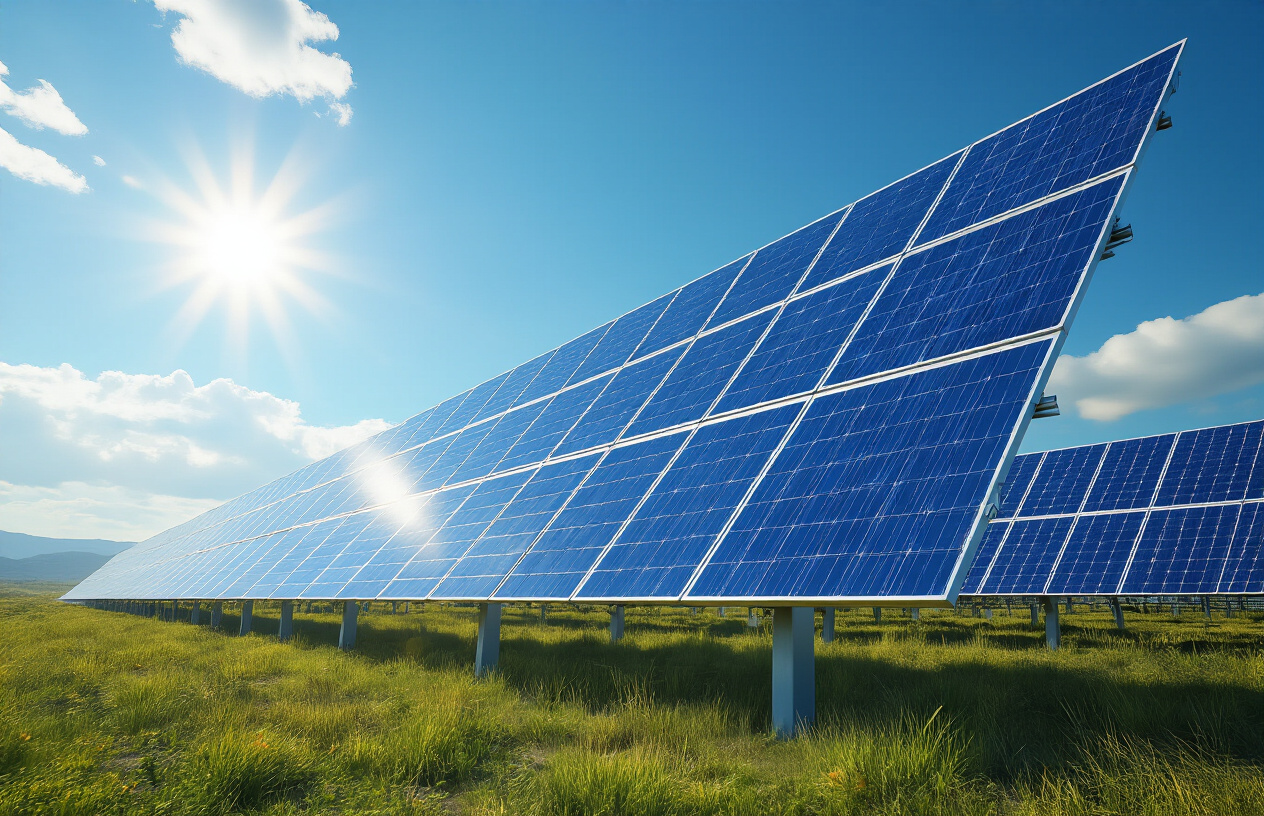
Photovoltaic panels convert sunlight directly into usable power
Photovoltaic (PV) panels work through a fascinating process called the photovoltaic effect, where solar cells made from silicon semiconductor materials generate electricity when sunlight hits them. When photons from sunlight strike the solar cells, they knock electrons loose from atoms, creating an electric current that flows through the panel's wiring system. This direct conversion happens instantly - as soon as sunlight touches the panels, electricity begins flowing.
Modern PV systems come in three main types: monocrystalline, polycrystalline, and thin-film panels. Monocrystalline panels offer the highest efficiency rates, typically converting 20-22% of sunlight into electricity, while polycrystalline panels provide a more budget-friendly option with efficiency rates around 15-17%. Thin-film panels, though less efficient, work well in low-light conditions and offer flexibility for unique installation scenarios.
The electricity generated by PV panels starts as direct current (DC), which gets converted to alternating current (AC) through an inverter system. This AC power can then power your home's electrical systems or feed back into the grid through net metering programs.
Concentrated solar power systems generate electricity through heat
Concentrated Solar Power (CSP) technology takes a completely different approach by using mirrors or lenses to focus sunlight onto a central receiver, creating intense heat that drives steam turbines to generate electricity. These large-scale installations typically feature thousands of mirrors called heliostats that track the sun throughout the day, concentrating solar energy to temperatures exceeding 1,000°F.
CSP plants come in four main configurations: parabolic troughs, solar power towers, parabolic dishes, and linear Fresnel reflectors. Solar power towers use a field of mirrors to focus sunlight onto a central receiver tower, where molten salt stores the thermal energy. This stored heat can continue generating electricity even after sunset, giving CSP a significant advantage over traditional PV systems.
The thermal storage capability makes CSP particularly valuable for grid stability, as these plants can provide consistent power output for 6-15 hours after the sun goes down. Countries like Spain, Morocco, and parts of the southwestern United States have embraced CSP technology for utility-scale power generation.
Reduces electricity bills while increasing property values
Solar installations deliver immediate financial benefits through reduced monthly electricity bills, with many homeowners seeing 50-90% reductions in their energy costs. Net metering programs allow solar system owners to sell excess electricity back to the utility company, creating additional savings or even positive cash flow during peak production months.
The financial impact extends beyond monthly savings. Multiple studies show that homes with solar panels sell for approximately 4% more than comparable homes without solar systems. This premium typically ranges from $15,000 to $20,000 for an average residential installation, making solar panels one of the few home improvements that pay for themselves while adding property value.
Solar systems also provide protection against rising electricity rates. While utility rates increase by an average of 2-3% annually, solar owners lock in their energy costs at installation. Over a typical 25-year system lifespan, these rate increases can result in tens of thousands of dollars in additional savings beyond the initial calculations.
Minimal maintenance requirements after initial installation
Solar panels are remarkably low-maintenance compared to other home energy systems. The lack of moving parts means there's very little that can break or wear out during normal operation. Most manufacturers warranty their panels for 20-25 years, and many systems continue producing electricity well beyond their warranty periods.
Routine maintenance consists mainly of occasional cleaning to remove dust, leaves, or snow that might reduce efficiency. In most climates, rain naturally cleans the panels, though areas with heavy dust or bird activity may benefit from professional cleaning once or twice yearly. Monitoring systems alert owners to any performance issues, and most problems can be diagnosed remotely.
The inverter system typically requires replacement once during the panels' lifetime, usually after 10-15 years of operation. However, newer microinverter and power optimizer technologies extend equipment life and make troubleshooting easier. Professional inspections every few years help identify any wiring issues or physical damage, but these are rare occurrences that don't significantly impact the overall cost-effectiveness of solar installations.
Wind Power Harnesses Natural Air Currents for Energy Generation

Onshore wind turbines provide cost-effective renewable electricity
Wind turbines scattered across farmlands and rolling hills have become the workhorses of renewable energy. These massive structures, standing 250-400 feet tall, capture moving air and convert it into electricity through simple yet brilliant engineering. The three-blade design rotates at 20-40 revolutions per minute, spinning a generator that produces clean power.
The economics make onshore wind incredibly attractive. Installation costs have dropped by over 70% in the past decade, making it one of the cheapest energy sources available. A single modern turbine can power 600-1,500 homes, depending on wind conditions and turbine size. Wind farms can generate electricity for as little as $0.02-0.05 per kilowatt-hour, competing directly with fossil fuels without subsidies.
Location matters tremendously. The best sites experience consistent winds of 15+ mph at hub height. Texas leads the United States in wind capacity, followed by Iowa and Oklahoma. These regions benefit from steady wind patterns and open spaces perfect for turbine placement.
Modern turbines feature advanced technology including variable pitch blades, smart sensors, and predictive maintenance systems. These innovations maximize energy capture while minimizing downtime. Turbines typically operate for 25-30 years, providing decades of clean electricity generation.
Offshore wind farms deliver higher energy yields consistently
Ocean winds blow stronger and more consistently than their land-based counterparts, making offshore wind farms incredibly productive. Wind speeds over water average 25-35% higher than onshore locations, translating directly into more electricity generation. The relationship isn't linear either – small increases in wind speed create exponential gains in power output.
Offshore turbines can be built larger since transportation constraints don't apply. These giants reach heights of 500+ feet with rotor diameters exceeding 650 feet. Each turbine can generate 8-15 megawatts compared to 2-3 megawatts for typical onshore units.
| Comparison Factor | Onshore Wind | Offshore Wind |
|---|---|---|
| Average Wind Speed | 15-25 mph | 20-35 mph |
| Turbine Capacity | 2-3 MW | 8-15 MW |
| Capacity Factor | 35-45% | 45-60% |
| Installation Cost | Lower | Higher |
European countries like Denmark, Germany, and the UK pioneered offshore wind development. The United States is rapidly catching up with major projects off the coasts of Massachusetts, New York, and Virginia. These floating wind platforms can access deeper waters where winds blow strongest and most reliably.
The main challenge remains cost – offshore projects require specialized vessels, underwater cables, and marine construction expertise. However, economies of scale and technological advances continue driving costs down rapidly.
Creates local jobs and economic opportunities in rural communities
Wind energy brings substantial economic benefits to rural areas that often struggle with limited job opportunities. A typical wind farm employs 20-50 full-time workers for operations and maintenance over its 25-year lifespan. These positions offer competitive wages, often 20-30% above local averages, and require specialized technical skills.
Manufacturing facilities supporting wind energy create even more employment. Blade factories, tower manufacturing plants, and component assembly facilities often locate in rural regions with available land and workforce. Iowa, for example, hosts multiple wind turbine manufacturing plants that employ thousands of workers.
Landowners who lease their property for wind turbines receive steady income streams. Annual lease payments typically range from $3,000-8,000 per turbine, providing farmers and ranchers with drought-resistant revenue. The turbines occupy less than 2% of the land, allowing continued agricultural use between towers.
Local communities benefit from increased tax revenue. Wind projects contribute millions in property taxes annually to rural school districts and local governments. These funds support infrastructure improvements, education, and essential services that might otherwise face budget constraints.
The supply chain extends throughout surrounding communities. Local businesses provide services like concrete, electrical work, road maintenance, and security. Hotels, restaurants, and equipment suppliers see increased business during construction phases. This economic multiplier effect strengthens entire regional economies around wind development areas.
Hydroelectric Energy Captures Moving Water for Reliable Power

Large-scale dams generate massive amounts of clean electricity
Massive hydroelectric dams represent some of the most impressive feats of engineering on our planet. These towering structures channel the power of entire rivers to produce enormous quantities of electricity. The Hoover Dam in the United States generates enough power for 1.3 million people, while China's Three Gorges Dam produces an astounding 22,500 megawatts of capacity. These installations create artificial reservoirs that store vast amounts of water, releasing it through turbines to generate consistent, reliable power.
The beauty of large-scale hydroelectric systems lies in their longevity and efficiency. Once built, these dams can operate for 50 to 100 years with minimal maintenance. They convert roughly 90% of available energy into electricity, making them far more efficient than fossil fuel plants that typically achieve only 35-40% efficiency. During peak demand periods, operators can quickly release more water through the turbines, providing instant power adjustments that help stabilize electrical grids.
Small-scale micro-hydro systems serve remote communities effectively
Micro-hydro systems bring renewable energy to places where large dams aren't feasible or necessary. These compact installations typically generate between 5 kilowatts and 100 kilowatts of power, making them perfect for isolated villages, farms, and small communities. Unlike their massive counterparts, micro-hydro systems can be installed on small streams and rivers without major environmental disruption.
These systems shine in mountainous regions where natural water flow creates sufficient pressure head. A simple setup involves diverting a portion of stream water through a penstock (pipe) to a small turbine housed in a powerhouse. The water then returns to the stream, leaving the natural flow largely undisturbed. Rural communities in Nepal, Peru, and parts of Canada rely heavily on micro-hydro systems to power homes, schools, and small businesses where grid connections would be prohibitively expensive.
Pumped-storage hydropower provides grid stability and energy storage
Pumped-storage hydropower acts like a giant battery for the electrical grid. During periods of low electricity demand, excess power from other sources pumps water from a lower reservoir to an upper reservoir. When electricity demand peaks, the stored water flows back down through turbines, generating power on command. This process typically achieves 70-85% efficiency, making it one of the most effective large-scale energy storage methods available.
These facilities prove invaluable for balancing renewable energy sources like wind and solar that produce power intermittently. When wind turbines generate excess electricity at night, pumped-storage systems can store that energy as elevated water. During hot summer afternoons when air conditioning demand soars but wind speeds drop, the stored water releases its energy back to the grid. Countries like Switzerland generate nearly 60% of their electricity storage capacity through pumped-storage systems.
Run-of-river systems minimize environmental impact while producing power
Run-of-river hydroelectric systems generate power without creating large reservoirs or significantly altering natural water flow. These installations divert a portion of river water through turbines and immediately return it downstream, maintaining the river's original character while producing clean electricity. This approach dramatically reduces environmental concerns associated with traditional dam construction.
Small weirs or intake structures channel water into penstocks that feed turbines, but fish can still migrate upstream and downstream relatively freely. Many run-of-river systems include fish ladders or bypass channels that allow salmon and other species to continue their natural migration patterns. British Columbia operates numerous run-of-river projects that generate power while preserving watershed ecosystems. These systems work particularly well on rivers with consistent year-round flow, though power output varies seasonally with natural water levels.
Geothermal Energy Taps Earth's Natural Heat for Consistent Power
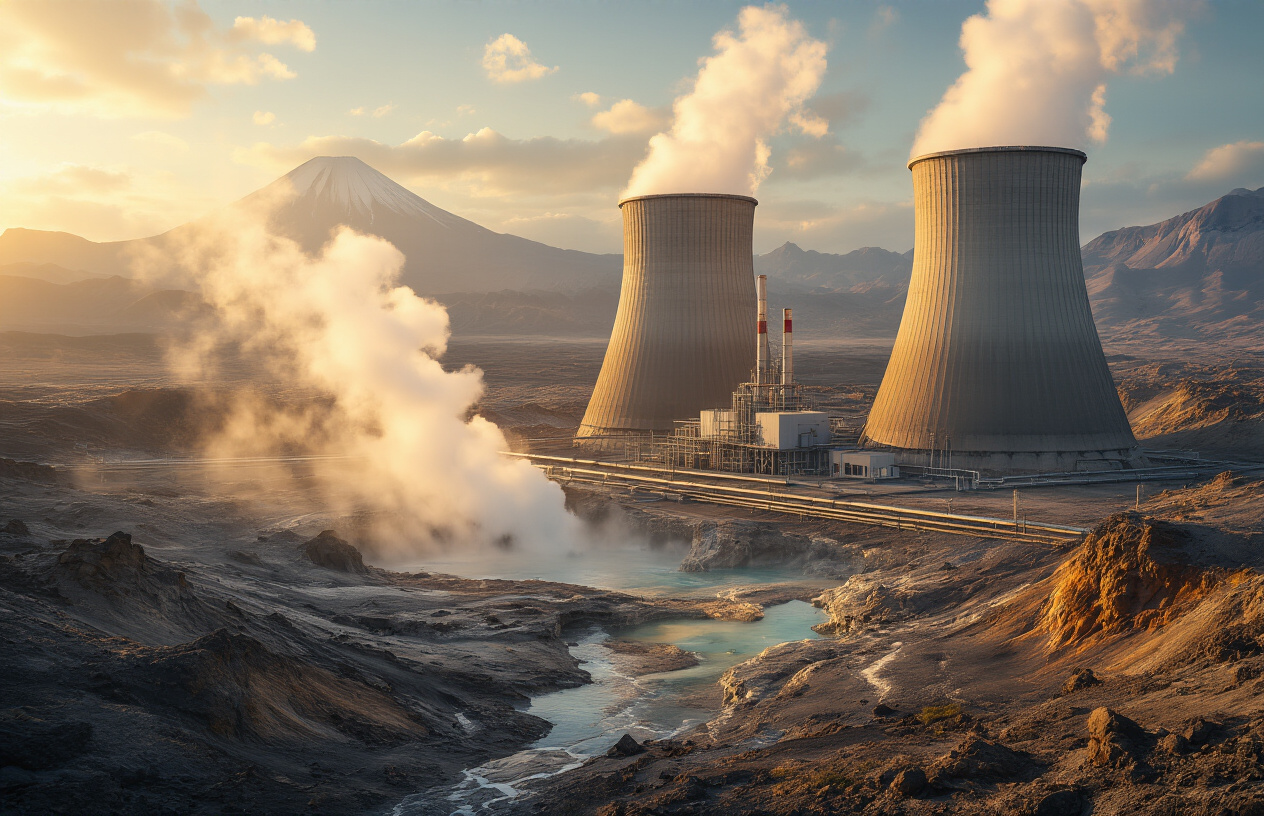
Geothermal power plants deliver 24/7 baseload renewable electricity
Geothermal power plants stand out from other renewable energy sources because they generate electricity around the clock, regardless of weather conditions. These facilities tap into underground reservoirs of hot water and steam, typically located 1-3 miles beneath the Earth's surface where temperatures reach 300-700°F. The consistent heat from the planet's core creates a reliable energy source that doesn't depend on sunshine or wind patterns.
Three main types of geothermal power plants exist: dry steam, flash steam, and binary cycle plants. Dry steam plants directly use steam from underground reservoirs to turn turbines. Flash steam plants pump high-pressure hot water to the surface, where it "flashes" into steam when pressure drops. Binary cycle plants transfer heat from geothermal water to a secondary fluid with a lower boiling point, creating vapor to drive turbines.
The United States leads global geothermal electricity production, with California generating over 2,700 megawatts from facilities like The Geysers complex. Iceland produces nearly 30% of its electricity from geothermal sources, while countries like Kenya, Philippines, and New Zealand have rapidly expanded their geothermal capacity. These plants typically operate at 90-95% capacity factors, far exceeding solar (25%) or wind (35%) reliability rates.
Ground-source heat pumps efficiently heat and cool buildings
Ground-source heat pumps (GSHPs) take advantage of stable underground temperatures just 6-8 feet below the surface. At this depth, soil temperatures remain relatively constant year-round – typically 45-58°F depending on geographic location. This consistency allows heat pumps to move thermal energy between buildings and the ground with remarkable efficiency.
During winter, GSHPs extract heat from the warmer ground and transfer it indoors. In summer, the process reverses, removing heat from buildings and depositing it into the cooler ground. The system includes a heat pump unit, underground loop system filled with water or antifreeze solution, and a distribution system for heated or cooled air.
These systems achieve coefficient of performance (COP) ratings of 3.0-5.0, meaning they produce 3-5 units of heating or cooling for every unit of electricity consumed. Traditional electric resistance heating has a COP of only 1.0. GSHPs reduce energy consumption by 25-50% compared to conventional heating and cooling systems, while providing superior comfort control and lasting 20-25 years with minimal maintenance.
Direct-use applications provide heating for greenhouses and industries
Geothermal direct-use applications bypass electricity generation entirely, using hot water or steam directly for heating purposes. These systems work with lower temperature geothermal resources (50-300°F) that might not be suitable for power generation but perfect for space heating, agricultural processes, and industrial applications.
Agricultural operations benefit tremendously from geothermal direct-use systems. Greenhouse complexes in states like Idaho, Oregon, and Nevada use geothermal water to maintain optimal growing temperatures year-round, extending growing seasons and increasing crop yields. Fish farms and aquaculture facilities maintain precise water temperatures for optimal fish growth and breeding.
Industrial applications include food processing, lumber drying, and mineral extraction. Geothermal district heating systems warm entire communities, with networks of insulated pipes distributing hot water from geothermal sources to homes and businesses. Boise, Idaho operates one of the largest geothermal district heating systems in the United States, serving over 5 million square feet of building space.
The economic advantages are substantial – direct-use systems typically cost 30-70% less to operate than conventional heating methods, with payback periods of 2-10 years depending on local energy costs and system size.
Biomass Energy Converts Organic Materials Into Sustainable Fuel
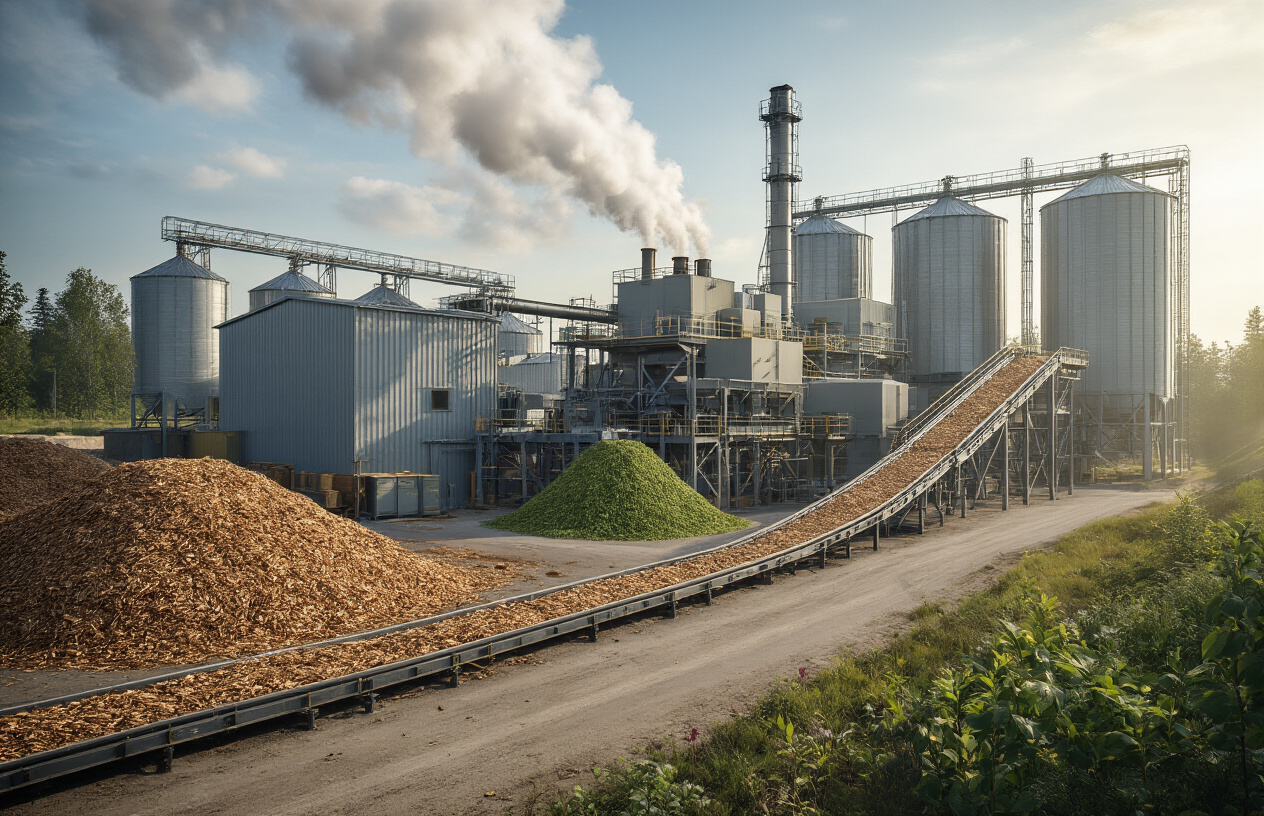
Wood pellets and chips offer carbon-neutral heating solutions
Wood pellets and chips have become popular alternatives for home heating systems, especially in rural areas where traditional heating costs run high. These compressed wood products burn much cleaner than traditional firewood, producing minimal smoke and ash while delivering consistent heat output. The manufacturing process involves compressing sawdust, wood shavings, and other lumber industry byproducts into dense pellets or chips that store easily and feed automatically into specialized stoves and boilers.
The carbon-neutral aspect comes from the fact that trees absorb carbon dioxide as they grow, and this same amount gets released when the wood burns. Unlike fossil fuels that release ancient carbon into the atmosphere, wood pellets create a closed carbon cycle. Modern pellet stoves achieve efficiency ratings of 85-90%, significantly higher than traditional wood-burning fireplaces that often lose most of their heat up the chimney.
Agricultural waste transforms into clean-burning biofuels
Farm operations generate massive amounts of organic waste that traditionally got burned in fields or left to decompose. Today, this agricultural residue becomes valuable feedstock for biofuel production. Corn stalks, wheat straw, rice husks, and sugar cane bagasse can all be converted into ethanol or biodiesel through various processing methods.
The conversion process breaks down cellulose and lignin in plant matter into sugars, which then ferment into alcohol-based fuels. This approach reduces dependence on food crops for fuel production, addressing the "food versus fuel" debate that surrounded earlier biofuel initiatives. Agricultural waste biofuels can power vehicles directly or blend with conventional gasoline and diesel to reduce emissions.
Biogas from organic waste provides renewable heating and electricity
Anaerobic digestion transforms organic waste into methane-rich biogas that burns cleanly for heating and electricity generation. Landfills, wastewater treatment plants, and livestock operations naturally produce biogas as organic matter decomposes without oxygen. Captured and refined, this gas becomes a reliable energy source that would otherwise escape as greenhouse gas emissions.
Small-scale biogas digesters work well for individual farms and households, processing kitchen scraps, animal manure, and garden waste into cooking fuel and fertilizer byproducts. Larger commercial facilities process municipal solid waste and sewage sludge, generating enough electricity to power thousands of homes while reducing waste management costs.
Algae-based biofuels present promising transportation fuel alternatives
Algae grows incredibly fast and produces oil yields per acre that far exceed traditional crop-based biofuels. Some algae species double their biomass daily under optimal conditions, and certain varieties contain 50-80% oil by weight. This oil can be extracted and refined into biodiesel, jet fuel, or gasoline substitutes without requiring fertile farmland that competes with food production.
Algae cultivation happens in controlled environments like ponds, bioreactors, or photobioreactors that maximize growth while minimizing water and nutrient requirements. The process also captures carbon dioxide from industrial emissions or the atmosphere, making algae biofuels potentially carbon-negative. While commercial production costs remain higher than conventional fuels, ongoing research focuses on improving cultivation methods and extraction efficiency to make algae-based fuels economically competitive.
Ocean Energy Utilizes Waves and Tides for Predictable Power
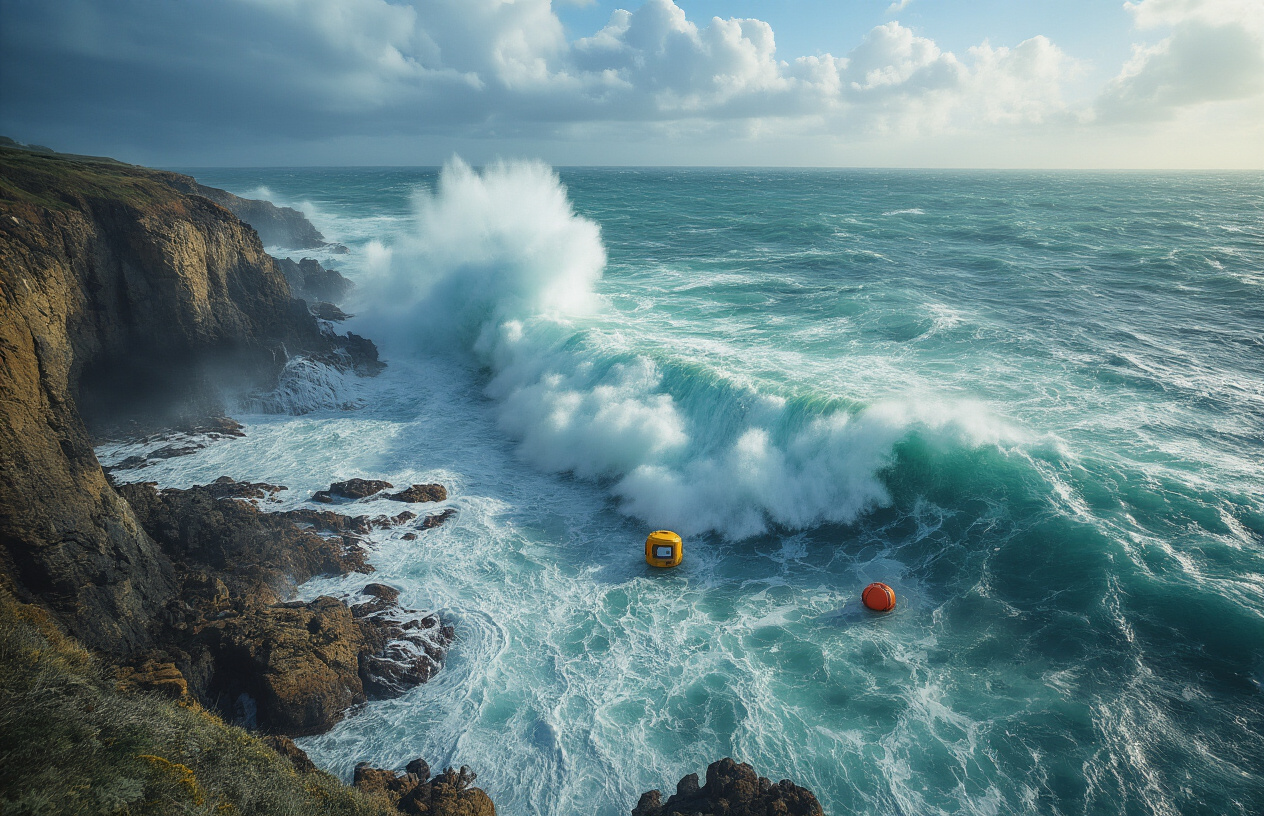
Tidal energy systems generate electricity from predictable ocean movements
Tidal energy stands out as one of the most reliable renewable energy sources because ocean tides follow predictable patterns based on gravitational forces from the moon and sun. These systems work by capturing the kinetic energy from moving water as tides flow in and out of coastal areas twice daily.
Tidal barrages represent the most established technology, functioning like underwater dams across estuaries or bays. As tides rise and fall, water flows through turbines in both directions, generating electricity consistently. The La Rance Tidal Power Station in France has operated successfully since 1966, demonstrating the long-term viability of this approach.
Tidal stream generators offer a less invasive alternative, resembling underwater wind turbines positioned in areas with strong tidal currents. These devices rotate as water flows past them, converting the motion into electrical energy. Scotland's MeyGen project showcases this technology's potential, with turbines generating power from the Pentland Firth's powerful currents.
The predictability of tides gives this technology a significant advantage over solar and wind power. Engineers can forecast energy output months in advance, making grid integration more manageable and reliable for electricity planning.
Wave energy converters capture power from ocean surface motion
Wave energy systems harness the constant motion of ocean waves, which carry tremendous amounts of energy across vast distances. These converters use various mechanical approaches to transform the up-and-down and back-and-forth motion of waves into rotational energy that drives electrical generators.
Point absorbers represent one popular design, featuring floating buoys that move with wave motion. As waves pass beneath these devices, the vertical movement operates hydraulic systems or direct-drive generators. The PowerBuoy system exemplifies this technology, using the relative motion between a floating buoy and a submerged component to generate electricity.
Oscillating water columns create another effective approach, using partially submerged chambers where waves cause air inside to compress and decompress. This air movement drives turbines positioned at the top of the chamber. The Wavegen LIMPET device in Scotland successfully demonstrates this concept.
Attenuator systems stretch perpendicular to wave direction, flexing as waves pass along their length. The famous Pelamis Wave Energy Converter used this snake-like design, with hydraulic joints between sections converting the flexing motion into electrical power.
Wave energy offers enormous potential since ocean waves carry energy densities up to 100 kilowatts per meter of wave front, far exceeding most other renewable sources.
Ocean thermal energy conversion uses temperature differences for electricity
Ocean Thermal Energy Conversion (OTEC) systems exploit the temperature difference between warm surface waters and cold deep ocean waters to generate electricity. This temperature gradient, typically 20°C or greater in tropical regions, provides the driving force for specialized heat engines that operate continuously.
Closed-cycle OTEC systems use the warm surface water to vaporize a working fluid with a low boiling point, such as ammonia. This vapor drives a turbine connected to a generator, then gets condensed back to liquid using cold deep water pumped from depths of 1,000 meters or more. The cycle repeats continuously, producing steady electrical output.
Open-cycle systems take a different approach, using the warm seawater itself as the working fluid. The water gets flash-evaporated in a low-pressure chamber, creating steam that drives the turbine. Cold deep water then condenses the steam back to liquid form.
The Hawaii Natural Energy Institute operates a successful OTEC demonstration plant that has generated electricity for decades. These systems work best in tropical locations where surface temperatures stay above 24°C year-round and deep water remains consistently cold.
OTEC technology offers unique advantages including baseload power generation capability and the potential for additional benefits like fresh water production and aquaculture support through the nutrient-rich deep water brought to the surface.
Hydrogen Energy Stores and Delivers Clean Power On-Demand

Green hydrogen production uses renewable electricity for zero-emission fuel
Green hydrogen represents a game-changing approach to clean energy storage and delivery. Unlike conventional hydrogen production methods that rely on fossil fuels, green hydrogen gets created through electrolysis powered entirely by renewable energy sources like solar and wind. This process splits water molecules into hydrogen and oxygen using electricity, producing zero carbon emissions during the manufacturing phase.
The electrolysis process requires abundant renewable electricity, making it perfect for capturing excess solar and wind power that might otherwise go to waste. When solar panels generate more electricity than the grid needs during peak sunshine hours, that surplus energy can power electrolysis plants to create hydrogen. The same principle applies to windy days when turbines produce more power than immediate demand requires.
Several countries are investing heavily in green hydrogen infrastructure. Germany plans to become a global leader in hydrogen technology, while Australia is developing massive solar-powered hydrogen export facilities. These projects demonstrate how renewable energy can be transformed into a portable, storable fuel that travels across continents.
Fuel cells convert hydrogen into electricity with only water as byproduct
Fuel cells work like reverse electrolysis, combining hydrogen with oxygen from the air to generate electricity and produce only water vapor as waste. This electrochemical reaction happens silently and efficiently, making fuel cells ideal for applications where noise pollution matters or where emissions must be absolutely zero.
The beauty of fuel cell technology lies in its simplicity and cleanliness. Unlike combustion engines that burn fuel and create harmful pollutants, fuel cells generate power through a controlled chemical reaction. The only byproducts are electricity, heat, and pure water - so clean you could technically drink it.
Modern fuel cells achieve impressive efficiency rates, often converting 60% or more of hydrogen's energy content into usable electricity. This efficiency advantage becomes even more pronounced in applications like backup power systems, where fuel cells can run continuously for extended periods without maintenance.
Hydrogen storage enables long-term renewable energy preservation
One of renewable energy's biggest challenges is intermittency - solar panels don't work at night, and wind turbines stop when air currents die down. Hydrogen solves this problem by acting as a long-term energy storage medium that can hold renewable power for weeks, months, or even seasons.
Unlike batteries that lose charge over time, hydrogen can be stored indefinitely in pressurized tanks or underground caverns without degradation. This makes hydrogen perfect for seasonal energy storage, where summer solar production gets saved for winter heating demands. Countries like Norway are exploring massive underground hydrogen storage facilities in salt caverns that could power entire cities during renewable energy shortfalls.
Hydrogen storage also offers incredible energy density advantages. A single kilogram of hydrogen contains about three times more energy than a kilogram of gasoline, making it an extremely efficient way to store large amounts of renewable energy in compact spaces.
Transportation applications reduce emissions in heavy-duty vehicles
Heavy-duty transportation presents unique challenges that battery electric vehicles struggle to address. Long-haul trucking, shipping, and aviation require enormous amounts of energy and can't afford the weight penalties or charging delays associated with large battery packs. Hydrogen fuel cells offer a compelling solution for these demanding applications.
Hydrogen trucks can refuel in minutes rather than hours, matching the operational requirements of commercial transportation. Major manufacturers like Hyundai, Toyota, and Nikola are developing hydrogen-powered semi-trucks that deliver ranges exceeding 400 miles while carrying full cargo loads. These vehicles eliminate diesel emissions without compromising on performance or productivity.
The shipping industry is exploring hydrogen as a clean alternative to heavy fuel oil, which currently powers massive container ships across the world's oceans. Hydrogen-powered ships could dramatically reduce maritime emissions while maintaining the cargo capacity and range that global trade demands. Similarly, the aviation industry sees hydrogen as a potential solution for regional flights and eventually longer-distance air travel.
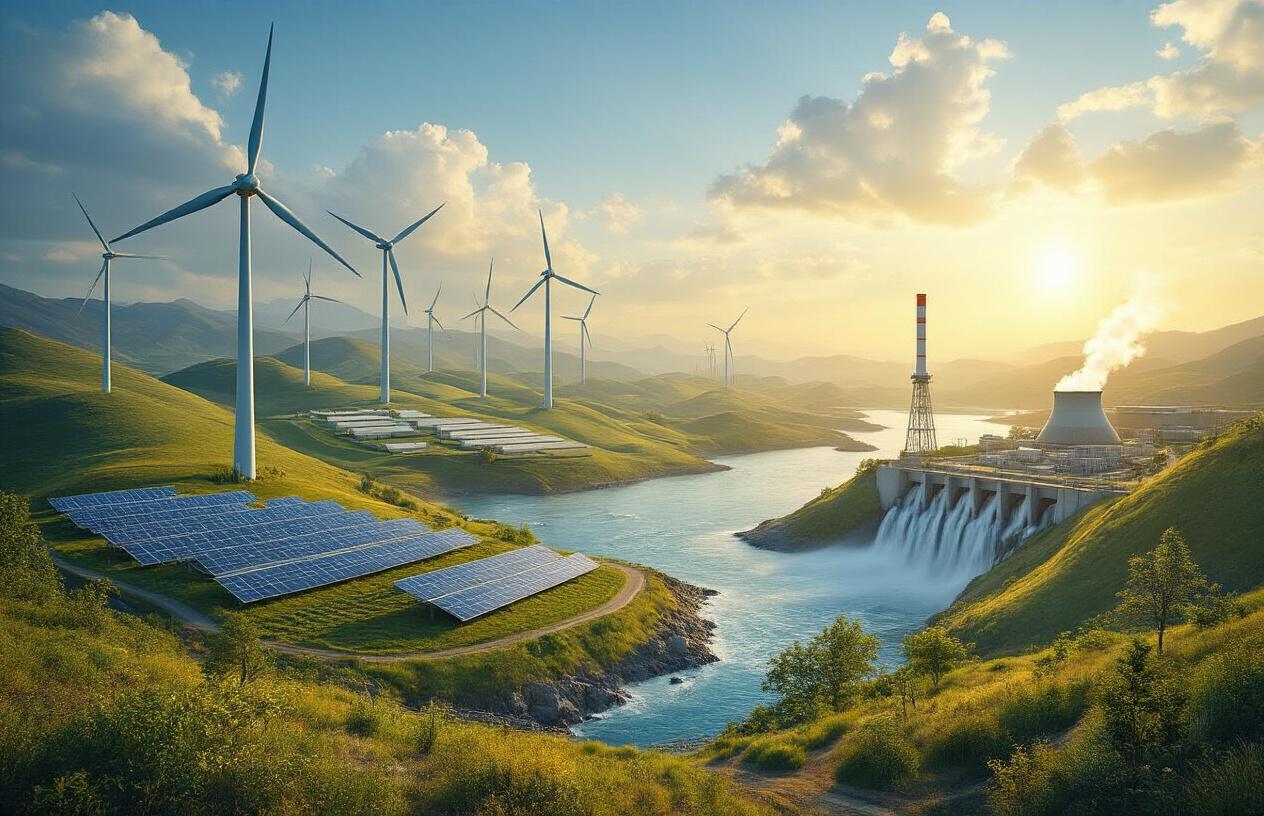
The seven renewable energy sources we've covered offer incredible potential to transform how we power our world. Solar panels can turn any sunny rooftop into an electricity generator, while wind turbines make use of natural breezes that never stop blowing. Water-based options like hydroelectric dams and ocean wave systems provide steady, predictable power, and geothermal taps into the Earth's own heat that's been building for millions of years. Even organic waste can be turned into useful energy through biomass, and hydrogen offers a way to store clean power for whenever we need it.
The best part about these renewable options is that they're getting cheaper and more efficient every year. Many of these technologies are already competitive with traditional fossil fuels, and some are even less expensive. Whether you're thinking about adding solar panels to your home, supporting wind farms in your community, or just wanting to understand where clean energy comes from, these seven sources show us that a sustainable energy future isn't just possible – it's already happening. The key is choosing the right mix of these technologies based on what works best in your area.

